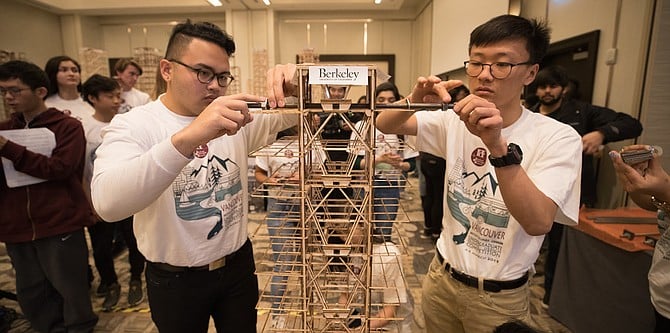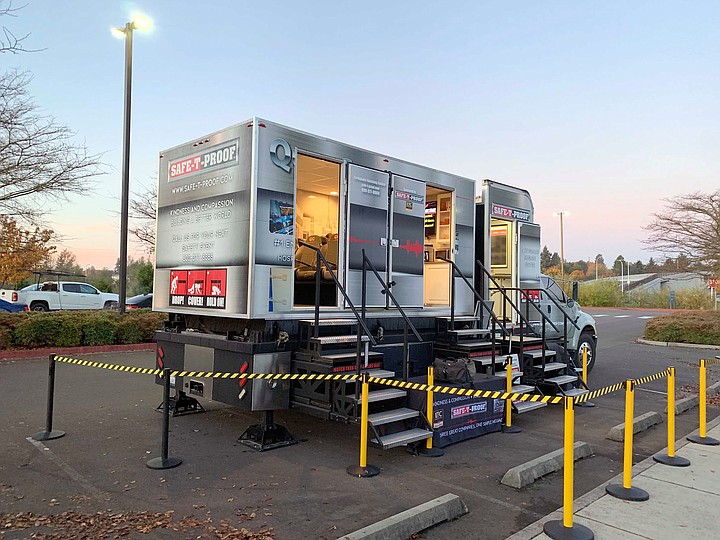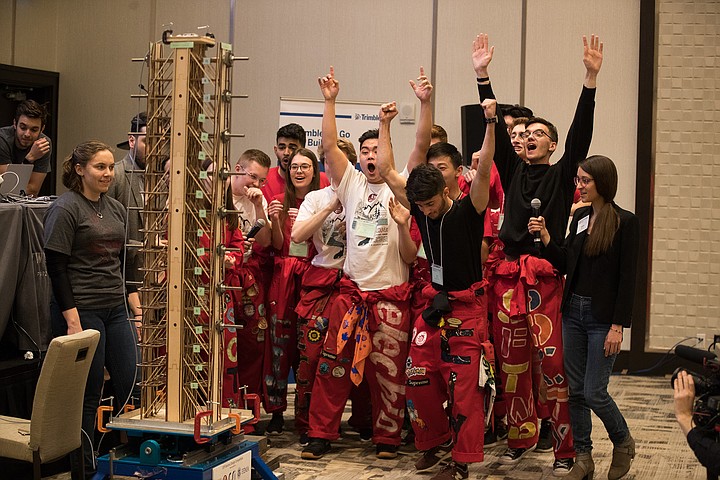 Facebook
Facebook
 X
X
 Instagram
Instagram
 TikTok
TikTok
 Youtube
Youtube

“This scenario report concludes that the San Diego region could suffer severe damage to its buildings and lifeline infrastructure with devastating consequences to the communities and economy following a major RCFZ earthquake,” says the San Diego Earthquake Planning Scenario, Magnitude 6.9 on the Rose Canyon Fault Zone — in part.
The 2020 earthquake scenario was released on March 4 at the National Earthquake Conference in the downtown Sheraton San Diego Hotel and Marina. The scenario, which takes place atop the Rose Canyon Fault Zone — took experts in emergency management, geoscience and engineering fields over five years to create.

A scenario “represents one realization of a potential future earthquake by assuming a particular magnitude, location, and fault-rupture geometry and estimating shaking using a variety of strategies,” says the U.S. Geological Survey site in part. “In planning and coordinating emergency response, utilities, local government, and other organizations are best served by conducting training exercises based on realistic earthquake situations—ones similar to those they are most likely to face …. They can also be used to examine exposure of structures, lifelines, utilities, and transportation corridors to specified potential earthquakes.”
About 600 attendees registered from around the world to attended the March 4-6 quadrennial conference.
“It’s the who’s who of everyone from every different sector on earthquake,” said Leslie Henderson, the event co-organizer. “Our organization — Earthquake Engineering Research Institute — brings together all of the stakeholders, players and experts. So we’ve got the science people, which is great, but how do you activate the science, and you got people doing research — like my [specialty] is about risk communication findings in building codes.”

I spoke to Henderson on March 3, as she was prepping her opening speech for the event.
“How’s our building codes in reference to earthquakes?” I asked her.
“Mike, whats your address,” she asked, “We have a website, www.InspectToProtect.org that I can look it up at — we did a lot of work to make it simple.”
“As far as residential,” she responded, “you are completely green in San Diego. You have good building codes in California and it appears to be all green; green is current code adopted, red means code is not adopted or code out of date, and black is unavailable. There are five states that won’t even report their codes; we struggle mightily in Tennessee, and in counties of Texas — they don’t have building codes enforced across the board. There’s only 30-31 percent of the United States that has their building codes to meet the relevant hazard they can face, whether it’s an earthquake or something else. It’s a huge disconnect, so the conference is about closing those gaps, making sure everybody is up to the minute on different parts and pieces and then looking for those intersecting laces where we can really push through a breakthrough.”
“Why’d you choose San Diego for your conference this year?” I asked Henderson.
“Our organization has a partnership with San Diego County and the Chief Resilience Officer, Col. Gary Johnston,” she responded, “and we knew the 2020 scenario would be just about finished in time to be a topic at this conference. The scenario is a starting point — it’s a projection of findings and impacts that the local leadership can take to use and work, and it’s a model for that.”
The last earthquake scenario in San Diego was released in 1990, four years after two people in our county reportedly died due to the magnitude 5.4 Oceanside earthquake on July 13, 1986. Chula Vista resident Arless Wilson, 55, had a heart attack during the quake; she died at the hospital shortly after — according to New York Times. Then, an 87-year-old book collector died after he was rescued from his downtown San Diego apartment when he was “buried alive” underneath his books — says the Voice of San Diego.
At the 2014 South Napa earthquake “the one death was because of a television set” that struck the victim. “So the focus here in California is really on the non-structural element,” Henderson explained. “The property damage driver in San Diego and everywhere else, is the non-secure things, like water pipes and systems. Whenever I come to California, I always ask the Uber driver what are you thinking about with regards to earthquakes, and the answer is usually “I’m not”; then I’m like “what have you done to prepare for one? Do you know how to turn your gas off at your gas shut-off valve? Do you have any plan in place? — and the answer is usually that they do not.”
On March 3, I visited the EarthquakeTrack.com site, and it said San Diego had eight magnitude-1.5 or greater earthquakes in the last 30 days, plus the magnitude-2.3 quake in Julian.
“We were [north of San Diego] once with a veterinarian,” Henderson continued, “and he was real excited to tell us that the building code to his hospital was a strong structurally sound building code, and he was right. But when we looked inside, he had glass bottles of medicine on shelves with no brackets, unsecured crates for the animals — so we worked with him and said theres some additional things you can do, and he didn’t know that. Thats what we talk about in California, because we feel good about the codes, but inside your home or business, is different. We have videos of how to secure your light fixtures, TVs, shelves — and how to turn off your gas and how to make sure your gas hoses are secure so they don’t break during an earthquake, so you don’t have a fire and you are safe.”
Throughout the three-day conference, there were sessions and exhibits that featured the Ridgecrest earthquake sequence of July 2019, the San Diego Scenario ShakeMap fault map, exhibitors demonstrating retrofitting and other safety mechanisms, earthquake safety videos and earthquake animations, and a variety of guest speakers and presentations.
There was a seismic design competition where over 350 competitors from about 50 universities built and tested their four-foot-tall model buildings on an earthquake simulator — based on downtown San Diego parameters.
Nageon de Lestang travelled in from the Bay Area and Murray, 28, flew in from Colorado.
“Mike, can I make a request that you don’t call it a richter magnitude from the richter scale,” Murray said, “that’s an outdated term.”
“Yes, not a problem,” I said. “I remember feeling the magnitude 6.9 Bay Area and magnitude 6.7 Northridge earthquakes — I was hundreds of miles away and they were still scary — have you ever felt an earthquake?”; “no I have not,” she responded.
The Quake Cottage, an eight-seat “major” earthquake simulator, shook the visitors here which demonstrated the importance of using earthquake fasteners for cabinets, furniture, flat screen TVs, lab equipment, office equipment, refrigerators, cabinet doors, and more.
Henderson, who is also the president and CEO of Federal Alliance for Safe Homes Inc., flew in from Florida; she was in Puerto Rico a couple of months ago.
“In our organization, we do everything from hurricanes and earthquakes to wildfires,” she said, “and we work globally providing information to activate information. Earthquake in particular, this is the toughest one because on a science basis, theres so much that we don’t know and there’s the uncertainty. Getting the word out on earthquake is difficult because it comes with no warning and is not on the peoples’ minds, so connecting everybody might sound pretty basic — but thats half the battle.”
Our City website states: “according to the Southern California Earthquake Center, there is a 60 percent chance of a 6.7 or greater earthquake occurring in Southern California. Yet an American Red Cross survey conducted in 2004 shows only one in four households in the Western United States is prepared to face such an emergency.”


“This scenario report concludes that the San Diego region could suffer severe damage to its buildings and lifeline infrastructure with devastating consequences to the communities and economy following a major RCFZ earthquake,” says the San Diego Earthquake Planning Scenario, Magnitude 6.9 on the Rose Canyon Fault Zone — in part.
The 2020 earthquake scenario was released on March 4 at the National Earthquake Conference in the downtown Sheraton San Diego Hotel and Marina. The scenario, which takes place atop the Rose Canyon Fault Zone — took experts in emergency management, geoscience and engineering fields over five years to create.

A scenario “represents one realization of a potential future earthquake by assuming a particular magnitude, location, and fault-rupture geometry and estimating shaking using a variety of strategies,” says the U.S. Geological Survey site in part. “In planning and coordinating emergency response, utilities, local government, and other organizations are best served by conducting training exercises based on realistic earthquake situations—ones similar to those they are most likely to face …. They can also be used to examine exposure of structures, lifelines, utilities, and transportation corridors to specified potential earthquakes.”
About 600 attendees registered from around the world to attended the March 4-6 quadrennial conference.
“It’s the who’s who of everyone from every different sector on earthquake,” said Leslie Henderson, the event co-organizer. “Our organization — Earthquake Engineering Research Institute — brings together all of the stakeholders, players and experts. So we’ve got the science people, which is great, but how do you activate the science, and you got people doing research — like my [specialty] is about risk communication findings in building codes.”

I spoke to Henderson on March 3, as she was prepping her opening speech for the event.
“How’s our building codes in reference to earthquakes?” I asked her.
“Mike, whats your address,” she asked, “We have a website, www.InspectToProtect.org that I can look it up at — we did a lot of work to make it simple.”
“As far as residential,” she responded, “you are completely green in San Diego. You have good building codes in California and it appears to be all green; green is current code adopted, red means code is not adopted or code out of date, and black is unavailable. There are five states that won’t even report their codes; we struggle mightily in Tennessee, and in counties of Texas — they don’t have building codes enforced across the board. There’s only 30-31 percent of the United States that has their building codes to meet the relevant hazard they can face, whether it’s an earthquake or something else. It’s a huge disconnect, so the conference is about closing those gaps, making sure everybody is up to the minute on different parts and pieces and then looking for those intersecting laces where we can really push through a breakthrough.”
“Why’d you choose San Diego for your conference this year?” I asked Henderson.
“Our organization has a partnership with San Diego County and the Chief Resilience Officer, Col. Gary Johnston,” she responded, “and we knew the 2020 scenario would be just about finished in time to be a topic at this conference. The scenario is a starting point — it’s a projection of findings and impacts that the local leadership can take to use and work, and it’s a model for that.”
The last earthquake scenario in San Diego was released in 1990, four years after two people in our county reportedly died due to the magnitude 5.4 Oceanside earthquake on July 13, 1986. Chula Vista resident Arless Wilson, 55, had a heart attack during the quake; she died at the hospital shortly after — according to New York Times. Then, an 87-year-old book collector died after he was rescued from his downtown San Diego apartment when he was “buried alive” underneath his books — says the Voice of San Diego.
At the 2014 South Napa earthquake “the one death was because of a television set” that struck the victim. “So the focus here in California is really on the non-structural element,” Henderson explained. “The property damage driver in San Diego and everywhere else, is the non-secure things, like water pipes and systems. Whenever I come to California, I always ask the Uber driver what are you thinking about with regards to earthquakes, and the answer is usually “I’m not”; then I’m like “what have you done to prepare for one? Do you know how to turn your gas off at your gas shut-off valve? Do you have any plan in place? — and the answer is usually that they do not.”
On March 3, I visited the EarthquakeTrack.com site, and it said San Diego had eight magnitude-1.5 or greater earthquakes in the last 30 days, plus the magnitude-2.3 quake in Julian.
“We were [north of San Diego] once with a veterinarian,” Henderson continued, “and he was real excited to tell us that the building code to his hospital was a strong structurally sound building code, and he was right. But when we looked inside, he had glass bottles of medicine on shelves with no brackets, unsecured crates for the animals — so we worked with him and said theres some additional things you can do, and he didn’t know that. Thats what we talk about in California, because we feel good about the codes, but inside your home or business, is different. We have videos of how to secure your light fixtures, TVs, shelves — and how to turn off your gas and how to make sure your gas hoses are secure so they don’t break during an earthquake, so you don’t have a fire and you are safe.”
Throughout the three-day conference, there were sessions and exhibits that featured the Ridgecrest earthquake sequence of July 2019, the San Diego Scenario ShakeMap fault map, exhibitors demonstrating retrofitting and other safety mechanisms, earthquake safety videos and earthquake animations, and a variety of guest speakers and presentations.
There was a seismic design competition where over 350 competitors from about 50 universities built and tested their four-foot-tall model buildings on an earthquake simulator — based on downtown San Diego parameters.
Nageon de Lestang travelled in from the Bay Area and Murray, 28, flew in from Colorado.
“Mike, can I make a request that you don’t call it a richter magnitude from the richter scale,” Murray said, “that’s an outdated term.”
“Yes, not a problem,” I said. “I remember feeling the magnitude 6.9 Bay Area and magnitude 6.7 Northridge earthquakes — I was hundreds of miles away and they were still scary — have you ever felt an earthquake?”; “no I have not,” she responded.
The Quake Cottage, an eight-seat “major” earthquake simulator, shook the visitors here which demonstrated the importance of using earthquake fasteners for cabinets, furniture, flat screen TVs, lab equipment, office equipment, refrigerators, cabinet doors, and more.
Henderson, who is also the president and CEO of Federal Alliance for Safe Homes Inc., flew in from Florida; she was in Puerto Rico a couple of months ago.
“In our organization, we do everything from hurricanes and earthquakes to wildfires,” she said, “and we work globally providing information to activate information. Earthquake in particular, this is the toughest one because on a science basis, theres so much that we don’t know and there’s the uncertainty. Getting the word out on earthquake is difficult because it comes with no warning and is not on the peoples’ minds, so connecting everybody might sound pretty basic — but thats half the battle.”
Our City website states: “according to the Southern California Earthquake Center, there is a 60 percent chance of a 6.7 or greater earthquake occurring in Southern California. Yet an American Red Cross survey conducted in 2004 shows only one in four households in the Western United States is prepared to face such an emergency.”
Comments